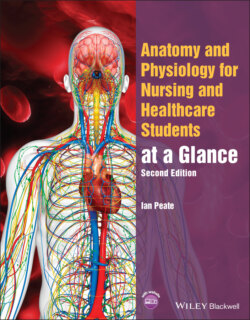Читать книгу Anatomy and Physiology for Nursing and Healthcare Students at a Glance - Ian Peate - Страница 20
Оглавление8 Inflammation and immunity
Figure 8.1 Types of acquired immunity.
Table 8.1 Types of antibodies.
| Type of antibody | Functions |
|---|---|
| IgA | Found in breast milk, mucous, saliva and tears prevents antigens from crossing epithelial membranes and invading the deeper tissues |
| IgD | Produced by B cells and is displayed on their surface. Antigens bind to active B cells here |
| IgE | The least common antibody. Found bound to tissue cell membranes particularly eosinophils |
| IgG | The most common and largest antibody. Attacks various pathogens, crossing the placenta to protect the fetus |
| IgM | Produced in large quantities, is the primary response and a powerful activator of complement |
Figure 8.2 The cells of the immune system.
Inflammation is one of the key processes stimulating the immune system. The immune response is how the body recognises and defends itself against bacteria, viruses and substances seen as foreign and potentially harmful.
Immunity
Immunity provides the opportunity to address disease and harm through defence mechanisms. When there is absence of resistance, this is known as susceptibility. There are two broad types of immunity: innate and aquired (also called adaptive).
Innate immunity
Innate (non‐specific) immunity refers to defences present at birth. Innate immunity does not involve specific recognition of a microbe, it acts against all microbes in the same way (hence non‐specific). Innate immune responses are the body’s early warning system and are intended to prevent microbes from entering the body and to help with the elimination of those that do enter the body.
The first line of defence against pathogens is the skin and mucous membranes of the body. These offer physical and chemical barriers that prevent pathogens and foreign substances gaining entry to the body and bringing about disease. When pathogens penetrate the physical and chemical barriers of the skin and mucous membranes, a second line of defence is encountered: internal antimicrobial substances, phagocytes, natural killer cells, inflammation and fever.
Acquired immunity
This is also known as specific immunity as it only responds to known, specific organisms that we have previously encountered (have previously infected us). The acquired immunity system remembers when a particular immunological threat has been met and overcome, recalling how to defeat it and mobilise the immune system to counter that threat (immunological memory). The acquired immune system is based upon lymphocytes, closely associated with the lymphatic system.
The primary response (exposure for the first time) produces a slow and delayed rise in antibody levels. The delay is associated with activation of the T lymphocyte system that stimulates B lymphocyte separation.
The secondary response occurs on subsequent exposure to the same antigen; the response in this case is much faster as the memory B lymphocytes generated after the first infection divide and separate at a much faster rate, and antibody production occurs almost immediately (see Table 8.1 for the five types of antibody).
Natural and artificially acquired immunity
Immunity can be acquired naturally or artificially; both can be active or passive (Figure 8.1).
When active immunity occurs, this indicates that the person has made a response to an antigen, leading to the production of their own antibodies with activation of lymphocytes; the memory cells offer long‐lasting resistance.
Passive immunity occurs when the individual has been given antibodies. This type of immunity is fairly short‐acting as the antibodies eventually break down.
Inflammation
When tissue damage occurs, a number of proteins are activated, the catalyst for the immune response. This response is non‐specific, attacking any and all foreign invaders in an attempt to rid the body of microbes, toxins or other foreign matter, aiming to prevent their spread to other tissues, preparing the site for tissue repair and restoring tissue homeostasis.
Cells of the immune system find and destroy damaged cells and foreign tissues, while recognising and preserving host cells (Figure 8.2). Four phases occur in the inflammatory response: redness, swelling, heat and pain.
When injury occurs, almost instantaneously the damaged cells instigate a number of events: vasodilation, release of messenger molecules, initiation of complement, extravasation of vascular components, phagocytosis and pain.
Injured mast cells release histamine, arterioles dilate and venules constrict, encouraging an increase in blood flow. The main mechanisms associated with vasodilation are the production of bradykinin (a vasodilator; also causes pain) and release of arachidonic acid, a fatty acid, a precursor to prostaglandins. Prostaglandins (vasodilators) can increase pain. Histamine from the degranulated mast cells enlarges pore size between capillary cells and proteins and other micromolecules move into interstitial spaces. Nitric oxide is released, causing further vasodilation; the presence of macrophages releases large quantities of nitric oxide.
Cells close to the injury release chemokines. The concentration of chemokines is greatest immediately surrounding the infection; high levels of chemokines attract phagocytic white blood cells, including neutrophils.
As chemokine concentration increases, the phagocytes leave the capillary, entering the site of infection; macrophages arrive around 24 hours later. Phagocytes engulf and destroy the pathogens present, recognising them as non‐self matter. The key molecule released is interleukin 1 which attracts neutrophils and macrophages to the site of injury, helping to clear away debris from the injured area.
Clinical practice point
Nurses and other health and social care professionals have a key role to play in promoting immunisation. This includes the administration of those vaccinations that are included in the childhood immunisation programme as well as those that are recommended for adults. Health and care professionals are an important and trusted source of advice with regard to vaccination. Discussion with parents and the public is time well spent and people welcome having the opportunity to ask questions and seek advice from reliable sources.
